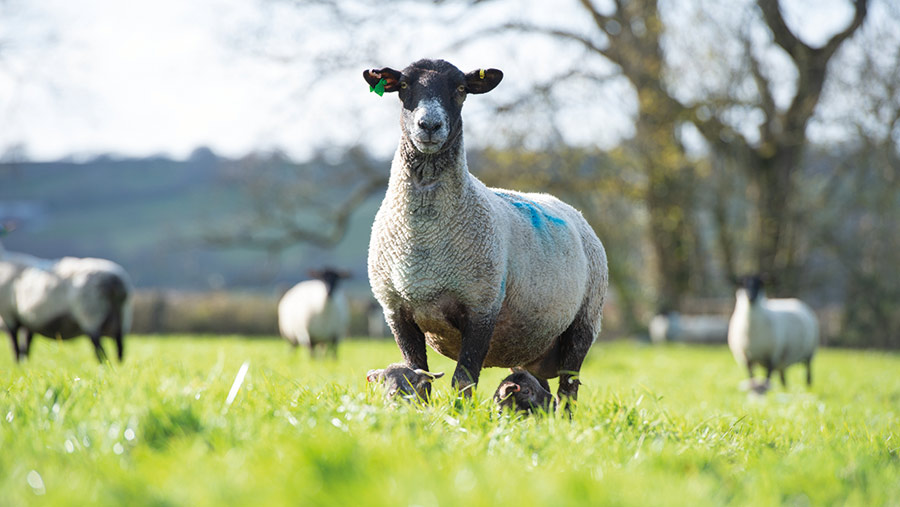Trial finds ewe data is route to bigger lamb cheque
 © Rothamsted
© Rothamsted Efforts to grow income from lamb sales should start with having sheep in optimal condition at lambing and tupping, a farm trial has shown.
A Rothamsted study, which analysed how flock records relate to eventual carcass value, adds to growing industry advice on the importance of body condition scoring of ewes.
The trial, which took place on Rothamsted’s North Wyke study farm near Okehampton, Devon, ranked “predictor” metrics (see “What are the different types of metrics?”). It found the top three for economic benefit were:
- Ewe weight at lambing = £3.34 a carcass
- Ewe body condition score (BCS) at lambing = £2.69 a carcass
- Ewe weight at tupping = £1.32 a carcass
See also: Ewe nutrition requirements through the production year
The team suggested this was because ewes in good condition milked well and lamb growth rates were higher. This meant lambs finished faster and left the farm earlier.
A lower stocking rate for autumn grazing would flush ewes, help fertility and scanning, or build up grass covers to minimise wintering costs.
This would knock on to the next year, taking ewes into tupping and lambing in good condition.
There were also ecological benefits (carbon sequestration, water run-off) from having lower autumn stocking rates.
By contrast, the three metrics of least economic benefit were ewe weight at weaning and BCS at tupping and weaning.
What are the different types of metrics?
- Predictors: Things to measure that influence production: birthweight, four-week weight, eight-week weight, weaning weight, average daily liveweight gain, body condition score (BCS), change in BCS, ewe weight, ewe weight change, percentage of lambs failing to reach target weight
- Outcomes: Outputs related to the product of the enterprise: slaughter age, fat class, kill-out percentage, cold carcass weight, lambs reared, weight of lamb reared/ewe that went to ram for tupping
- Descriptors: These are choices made by the farmer: ewe-to-ram ratio, percentage of ewes culled, flock replacement rate
Study outline
The study, published in Scientific Reports, tracked the performance of 389 Suffolk Mule ewes through Farmplan and flock electronic identification (EID) over five grazing seasons (2015-2019).
The 10 “predictor” metrics were correlated with eventual lamb values to assess each metric’s relevance as a predictor of economic return.
Flock facts
- Suffolk cross Mules put to Charollais terminal sires
- Grassland measured weekly in GrassCheck programme
- Continuous set stocking
- Lamb sold deadweight to Jaspers
- 13-week weaning
- March/April indoor lambing
- Scanning rate 192%, rearing rate 180%
Cost of recording
Andy Jones of Rothamsted Research said the analyses showed a positive economic benefit from recording information on farm, but stressed that information gathering was seldom free.
Whether it be labour cost on larger commercial farms or taking up time and affecting the profitability of a traditional family farm, there is a cost to gathering data.
Speaking on a GrassCheck webinar earlier this month, Dr Jones said: “We are certainly not telling farmers not to record or to record less. The message is to focus in on data and consider what drives income and what you can change practically and cost-effectively.”
Four tips for flock recording
1. Time is short, so prioritise ewe data over lamb data
If forced to make a choice, focus on ewe body condition score (BCS) and weight at tupping and lambing because these affect carcass value and have other knock-on effects
2. Identify optimal KPI combinations
Every farm and system are different, so look at flock performance to see what impacts earnings. The optimal number of predictor KPIs in the study was four. At North Wyke, this was ewe weight at lambing, ewe BCS at lambing, weaning weight and birthweight
3. Define practical benchmarks
Ewe weight at lambing: Don’t try changing the farm to lift a KPI if it’s impractical or costly to do so. For example, the biggest earning ewes weighed 84kg (range 69-86kg) at North Wyke, but breeding bigger ewes and putting condition son them increased maintenance and feed cost. The data showed ewes weighing at 77kg could earn almost as much
Birthweight: Also, while the heaviest third of lambs averaged 157.3 days to slaughter compared to the medium third of lambs, at 177.1 days, and the smallest third at 197.2 days, the practicalities of farming for heavy lambs would be outweighed by dystocia and possible increase in mortality
BCS: Ewe BCS at lambing could be manipulated with feeding but deferred grazing post-lambing or high-quality grass silage could be more viable
4. Consider the system
Birthweight: A small increase in birthweight at North Wyke could be investigated as it is an indoor lambing, terminal sire system. For an outdoor lamber, birthweight is best moderated or controlled
Eight-week weight: A store lamb producer may place more importance on weaning or eight-week weight to sell lambs straight off the ewe
Source: Andy Jones, Rothamsted, speaking at the recent GrassCheck GB online conference (3 February)
